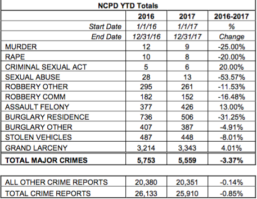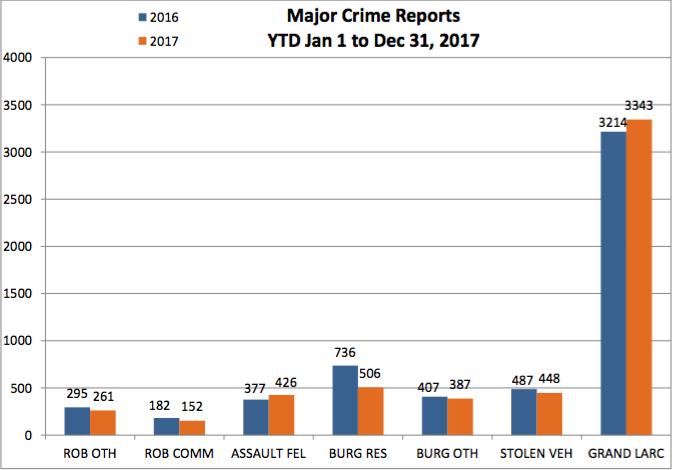The number of major crimes reported in Nassau County fell 3.47 percent last year, with the largest decline in sexual abuse at 53.57 percent, according to the Police Department.
A total of 5,559 major crimes were reported, compared with 5,753 in 2016.
A total of 25,910 crimes were reported, a 0.85 percent decrease.
The decrease in crime is a combination of a well-trained police staff with an increase in innovative practices, Nassau County Legislature Presiding Officer Richard Nicolello (R-New Hyde Park) said.
“The use of technology, I think that’s helping tremendously,” Nicolello said. “They should continue to use those methods going forward.”
Technology like license plate readers to help discern patterns in burglaries or figure out who is driving into an area, or computer modeling to see where crime is expected, is helping to keep crime rates down, Nicolello said.
The most frequently reported crime was grand larceny, which went up a little more than 4 percent to 3,343 cases.
Significant decreases in crime included a 31.25 percent drop in residence burglary, a 25 percent drop in murder and a 20 percent drop in rape.
Criminal sexual acts went up to six from five the previous year.
Nicolello said that the police’s focus on community crimes also helps keep major crime rate down.
In a separate report, Detective Lt. Richard LeBrun said there were 766 heroin arrests in 2017 and 639 opiate arrests.

There were also 131 opioid deaths reported in 2017 as of Sept. 9, and 195 deaths reported in 2016, according to Nassau County Police Commissioner Patrick Ryder.
This year, there have already been six fatalities due to heroin or opioid overdoses, and 46 nonfatal overdoses, Ryder told Newsday.
The opioid epidemic has been a focus for elected officials in the county, as it has across the nation.
Nicolello said that it is one of the main focuses for the Legislature.
He said that similar to other crimes, technology used by police will help keep rates down. For example, technology can identify hot spots to target drug dealers.
Nicollelo added that the county also needs to expand treatment options for those dealing with addiction.
Nassau County Legislator Josh Lafazan (D-Syosset), a 24-year-old freshman legislator, said that law enforcement would admit that “we can’t incarcerate ourselves out of this crisis.”
“This is the greatest natural disaster of our time,” Lafazan said. “And we have to attack this public health crisis through a lens of both prevention and treatment.”
Lafazan has a five-point plan to address the opioid epidemic, which includes creating a 24-hour open access center that functions like an urgent care facility and a 24-hour hotline.
The other parts of his plan include training every Nassau County employee in Narcan, opening a center where young people in recovery can socialize in a safe and sober environment and mandating that colleges in Nassau County offer substance free dormitories.
“I’ll tell you, as the lone millennial in the Legislature I don’t drink, I don’t smoke and I don’t do drugs, and it’s still difficult for me to navigate the social scene on Long Island because of the prevalence of alcohol and drugs,” Lafazan said. “To have a place for these young people to go that is safe and secure and sober is actually a form of prevention we know works.”
Lafazan added that addiction doesn’t discriminate between socioeconomic status, gender, race or ethnicity.
The opioid epidemic, he said, can be the “bipartisan issue of the 21st century.”
“If we can’t get together to solve this issue, then what are we even doing here,” Lafazan said.



